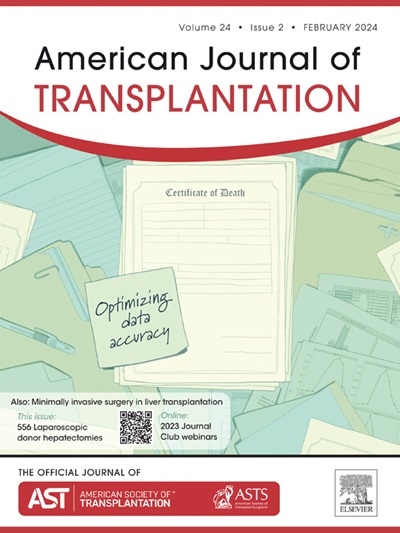肥胖患者肾移植候选人和受者的管理实践:美国移植项目调查
IF 8.2
2区 医学
Q1 SURGERY
引用次数: 0
摘要
肾脏移植项目对解决肥胖问题的兴趣越来越大。美国移植肾脏胰腺社区肥胖实践工作组调查了美国的项目,以确定评估、清单和体重管理实践的特征。一项基于网络的调查于2024年9月5日至9日对参与肾移植护理的专业人员(移植肾病学家/外科医生/协调员/营养师、内分泌学家、减肥外科医生、肥胖医学专家)进行。来自113个项目的275名受访者占美国移植量的70.7%。72.5%/74.3%的程序使用身体质量指数(BMI)临界值(通常为40 kg/m2)进行评估/列出。对于接受者来说,BMI 40 kg/m2是转诊进行医疗和手术减肥的最常见阈值。大多数(73.4%)学校都有体重管理项目;19.4%的人将移植项目纳入了他们的移植项目。不进行体重管理的最常见原因之一是首选初级保健提供者/普通肾脏科医生管理体重,特别是移植前。27.6%的项目提供机器人肾移植;38.5%仅对BMI阈值(32-40 kg/m2)以上的患者提供。肥胖管理是多种多样的。大多数使用BMI临界值(通常为40 kg/m2)进行评估和列出。这些数据提供了美国项目实践的最全面和最现代的概述。本文章由计算机程序翻译,如有差异,请以英文原文为准。
Practices in the management of kidney transplant candidates and recipients with obesity: A survey of United States transplant programs
There is growing kidney transplant program-level interest in addressing obesity. The American Society of Transplantation Kidney Pancreas Community of Practice Obesity Work Group surveyed US programs to characterize evaluation, listing, and weight management practices. A web-based survey was administered to professionals involved in kidney transplant care (transplant nephrologists/surgeons/coordinators/dietitians, endocrinologists, bariatric surgeons, and obesity medicine specialists) from May 2024 to September 2024. The 275 respondents from 113 programs represented 70.7% of the US transplant volume. A body mass index (BMI) cutoff—commonly 40 kg/m2—is used for evaluation/listing at 72.5%/74.3% of programs. For recipients, BMI 40 kg/m2 was the most common threshold for referral for medical and surgical weight loss. Most (73.4%) programs have weight management programs within their institution; 19.4% have a program integrated into their transplant program. One of the most common reasons for not referring for weight management was a preference that primary care providers/general nephrologists manage this, particularly pretransplant. Of programs, 27.6% offer robotic kidney transplantation; 38.5% offer it only to patients above a BMI threshold (32-40 kg/m2). Obesity management is heterogeneous. Most use a BMI cutoff—typically 40 kg/m2—for evaluation and listing. These data provide the most comprehensive and contemporary overview of practices at US programs.
求助全文
通过发布文献求助,成功后即可免费获取论文全文。
去求助
来源期刊
CiteScore
18.70
自引率
4.50%
发文量
346
审稿时长
26 days
期刊介绍:
The American Journal of Transplantation is a leading journal in the field of transplantation. It serves as a forum for debate and reassessment, an agent of change, and a major platform for promoting understanding, improving results, and advancing science. Published monthly, it provides an essential resource for researchers and clinicians worldwide.
The journal publishes original articles, case reports, invited reviews, letters to the editor, critical reviews, news features, consensus documents, and guidelines over 12 issues a year. It covers all major subject areas in transplantation, including thoracic (heart, lung), abdominal (kidney, liver, pancreas, islets), tissue and stem cell transplantation, organ and tissue donation and preservation, tissue injury, repair, inflammation, and aging, histocompatibility, drugs and pharmacology, graft survival, and prevention of graft dysfunction and failure. It also explores ethical and social issues in the field.

 求助内容:
求助内容: 应助结果提醒方式:
应助结果提醒方式:


